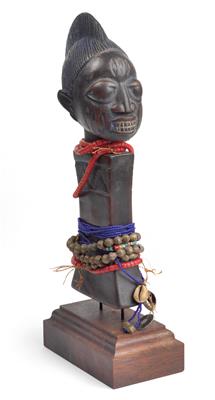Yoruba, Nigeria: A doll for girls, called ‘Omolangidi’. Style: Abeokuta.

Just like in our culture, the young girls of the Yoruba in Nigeria use dolls, such as the present one, as ‘babies’ in mother-child role plays.
The present ‘Omolangidi doll’ made of dark brown, hard wood is especially beautiful and carefully manufactured. The head displays the central, high crested coiffure characteristic of the Abeokuta style, dyed with ‘bluing’. The face features the slightly protruding Yoruba eyes, the typical tribal decorative scarification marks on the forehead and on both cheeks, as well as an open mouth with two rows of teeth (with old traces revealing that the ‘baby’ was ‘fed’ by its owners!).
The flat, rectangular, slightly curved body of the doll shows two bands of geometric, triangular chip-carving decorations on each side. Further ornaments of this ‘Omolangidi doll’ include red and blue glass pearl chains, a chain made of brass pearls, two pierced cowrie shells and a pierced British colonial coin with the minting date ‘1944’.
A perfectly crafted object with good usage patina. No damage.
First half of the 20th century; H: 28 cm. (ME)
Provenance: Austrian Private Collection.
Lit.: 'Yoruba. Nine Centuries of African Art and Thought' by Henry John Drewal & John Pemberton III, fig. 264.
Specialist: Erwin Melchardt
 Erwin Melchardt
Erwin Melchardt
+43-1-515 60-465
erwin.melchardt@dorotheum.at
26.05.2015 - 15:00
- Estimate:
-
EUR 1,600.- to EUR 2,000.-
Yoruba, Nigeria: A doll for girls, called ‘Omolangidi’. Style: Abeokuta.
Just like in our culture, the young girls of the Yoruba in Nigeria use dolls, such as the present one, as ‘babies’ in mother-child role plays.
The present ‘Omolangidi doll’ made of dark brown, hard wood is especially beautiful and carefully manufactured. The head displays the central, high crested coiffure characteristic of the Abeokuta style, dyed with ‘bluing’. The face features the slightly protruding Yoruba eyes, the typical tribal decorative scarification marks on the forehead and on both cheeks, as well as an open mouth with two rows of teeth (with old traces revealing that the ‘baby’ was ‘fed’ by its owners!).
The flat, rectangular, slightly curved body of the doll shows two bands of geometric, triangular chip-carving decorations on each side. Further ornaments of this ‘Omolangidi doll’ include red and blue glass pearl chains, a chain made of brass pearls, two pierced cowrie shells and a pierced British colonial coin with the minting date ‘1944’.
A perfectly crafted object with good usage patina. No damage.
First half of the 20th century; H: 28 cm. (ME)
Provenance: Austrian Private Collection.
Lit.: 'Yoruba. Nine Centuries of African Art and Thought' by Henry John Drewal & John Pemberton III, fig. 264.
Specialist: Erwin Melchardt
 Erwin Melchardt
Erwin Melchardt
+43-1-515 60-465
erwin.melchardt@dorotheum.at
|
Buyers hotline
Mon.-Fri.: 10.00am - 5.00pm
kundendienst@dorotheum.at +43 1 515 60 200 |
| Auction: | Tribal Art |
| Auction type: | Saleroom auction |
| Date: | 26.05.2015 - 15:00 |
| Location: | Vienna | Palais Dorotheum |
| Exhibition: | 20.05. - 26.05.2015 |
